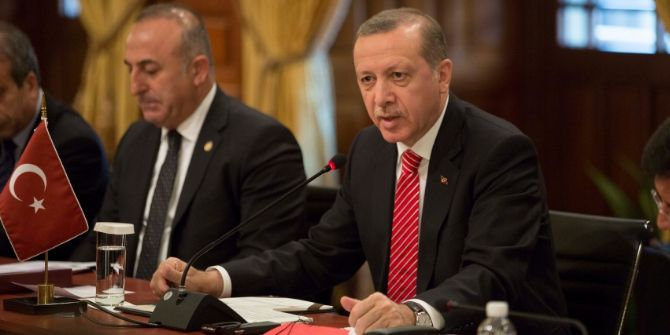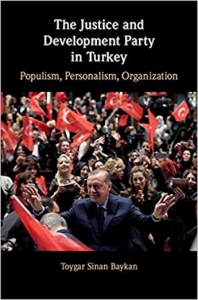In The Justice and Development Party in Turkey: Populism, Personalism, Organization,Toygar Sinan Baykan offers a sophisticated contribution to the existing literature on the JDP by shifting focus from structural analysis towards the role of party agency. This is an invaluable addition to the study of populism in Turkey, writes Nikos Christofis, opening up new ways to approach the JDP’s rise, structure and organisation.
The Justice and Development Party in Turkey: Populism, Personalism, Organization. Toygar Sinan Baykan. Cambridge University Press. 2018.
Toygar Sinan Baykan’s opening line in The Justice and Development Party in Turkey: Populism, Personalism, Organization that ‘Turkish politics was reshaped by a remarkable transformation at the beginning of the 2000s’ cannot be other than true. Since then a plethora of monographs, edited books and journal articles have emerged examining the rise and domination of the Justice and Development Party (JDP). Baykan notes the longstanding focus on the country’s economy and economic growth and the emphasis of several studies on the ‘Islamic bourgeoisie’ in Turkey and the relationship between this social group and the JDP (11). When it comes to populism however – a highly used and contested ism – Baykan observes that even theoretically nuanced analyses of the JDP’s populism still fail to ask whether we need to look at either redistributive tactics, ideology, discourse or strategy (or all of these) in order to define populism (11–12). In this respect, this book presents an invaluable addition to the study of populism in Turkey as it combines all of the above characteristics. Baykan’s focus on organisational agency shows that party organisation has been central to the JDP’s success: a much overlooked aspect of the JDP’s emergence into and consolidation of power. Therefore, The Justice and Development Party in Turkey is a welcome addition to the burgeoning literature on the JDP, filling as it does a glaring gap within it as it shifts its focus of analysis from structures to the neglected role of party agency.
The book is made up of eight chapters, an Introduction (Chapter One) which presents the author’s comprehensive overview of the field and a Conclusion, where the author also provides an agenda for further research. Furthermore, there are two appendices in the study, one on political parties and the other on the high-low (or anti-populism-populism) and left-right divides in Turkey. Although the second appendix makes perfect sense and clearly demonstrates the author’s intention to show where each party stands in the divide, the first on political parties offers little additional value to the study, since the information could have more readily been provided in a simple footnote.
The core strength of the book is the series of in-depth interviews (55 in total). These include interviews with JDP deputies and central elites as well as provincial and sub-provincial chairs (in Istanbul, Ankara, Konya, Trabzon, Mardin, Batman and Urfa) and neighbourhood representatives across Turkey. Other scholars have conducted interviews, of course, but few have paid attention to the ‘periphery’ as Baykan has done. To this reviewer, having reached deep into the field is a rare feat that demonstrates in its most complete form the party agency, structure and mentalité of the party members in general.

Image Credit: Recep Tayyip Erdogan on a state visit to Mexico, 2015 (Presidencia de la República Mexicana CC BY 2.0)
Chapter Two focuses on the historical, political and social background of the transformation of Islamism and the emergence of the JDP as the dominant political actor in the Turkish political scene. Borrowing from Asef Bayat, Baykan defines the JDP as a post-Islamist party as it does not adopt a top-down strategy to Islamise society, particularly through the seizure of the state. Baykan is extremely careful and meticulous – no term is left undefined, and not a single question he poses goes unanswered. The author’s sophisticated analysis can also be traced to the fact that Baykan resists easy answers. For example, he distances himself from the well-worn (if not worn out) paradigm that dominates numerous studies even today – namely, the bipolar schemes of secularism versus Islamism (i.e. religion) – to understand and explain the rise and persistence of the JDP in power. In so doing, he draws in other crucial factors, including the destruction of the leftist alternative after the 1980s and the Turkish-Islamic synthesis, the official conservative–nationalist indoctrination programme championed by the military junta following the 1980 coup (38–60; 257).
Chapter Three discusses concepts, such as cleavage, divide and populism. The JDP represents for Baykan an example of a very successful case of populism in power as it was successful in fundamentally altering the political system of Turkey from an electoral parliamentary democracy to a ‘competitive authoritarian presidentialism’. The ‘selective pluralism’, as the author calls it, of the weak liberal institutional heritage, the established way of representing socio-cultural divisions of society in politics, namely as a ‘high–low divide’, and a specific mode of agency (populism and the personalistic mass party) have helped towards this success. In Chapter Four, Baykan examines the role of President Erdoğan, who he rightly notes is ‘a product of [the] historical and structural context of Turkish politics’ (33). Here, Baykan makes in-depth use of the Weberian concept of charisma and proposes to take charismatic personalism as a genuinely rare phenomenon characterised by the robust transformational impact of the leader and their followers, supporters and organisation (106–41; 258–59). In so doing, he casts Erdoğan’s leadership as an example of ‘non-charismatic personalism’: i.e. an inventive and diligent organisation man who has exclusively focused on achieving and maintaining power.
Chapter Five argues that the JDP took a cautious stance in relation to the redistributive strategies championed by its predecessors in Turkey, and underlines the ways the JDP’s politics diverged from ‘classical centre-right patronage’. In order to remain in power for long, the long-term strategy of the JDP distanced itself from the National View tradition in terms of its communications strategy and put heavy emphasis on having a tight grip over the influential pro-JDP media (259). However, the author does not neglect to also stress the continuities with the National View tradition, especially its organisational culture. The large membership base of the organisation, inherited from the National View tradition, is dealt with in Chapter Six. What is of importance is that this was kept under the tight control of the central JDP elite through public opinion surveys, technological surveillance instruments and party co-ordinators, deputies and ministers in person, all of which was balanced through ‘controlled participation’ channels within the JDP (167–210; 260).
Chapter Seven continues with a discussion of the increasing domination of the party leadership brought about by the JDP’s intra-party governance structure. The author focuses particularly on its shift from a democratic entity – as defined in the party’s first statute – and how it slowly started to change under the direction of Erdoğan in collaboration with the party committee. Baykan demonstrates that the current concentration in the Turkish political system of extensive powers in the hands of the leader actually started a lot earlier inside the party itself, through changes in internal statutes and party organisation. This transformation took place, Baykan demonstrates with great dexterity, as the party leadership was able to select and support competent (highly educated and experienced) and, most importantly, ‘obedient candidates instead of popular local bosses by inhibiting factionalism through robust interventions into local and provincial party life’ (212).
Finally, Chapter Eight frames the party’s agency and its political manoeuvres at the elite level. Against the backdrop of Turkey’s authoritarian legacy, the author analyses the post-Islamist reaction of the JDP and the strategic and organisational orientation of the party leadership as a product of this authoritarian legacy. In this context, and totally in line with this legacy, ‘the JDP got rid of collective – and individual – power contenders within the Turkish political system at the expense of an intolerable increase in tensions among elite groups’ (261).
The Justice and Development Party in Turkey is a sophisticated analysis of JDP party agency, theoretically robust, well-researched and well-written. It not only adds to the JDP literature but also provides an intellectually succinct study that opens up new ways to approach the JDP’s rise, structure and organisation. This is definitely a work that every scholar and researcher of Turkish politics should read.
Please read our comments policy before commenting.
Note: This article is provided by our sister site, LSE Review of Books. It gives the views of the author, not the position of EUROPP – European Politics and Policy or the London School of Economics.
_________________________________
Nikos Christofis – Shaanxi Normal University
Nikos Christofis is an Associate Professor of Turkish history and politics at the Centre for Turkish Studies, Shaanxi Normal University, Xi’an, China.


 Find this book:
Find this book: 
